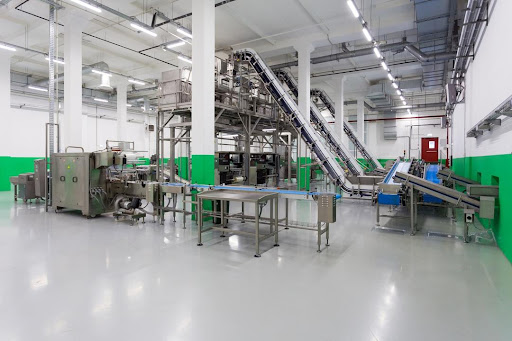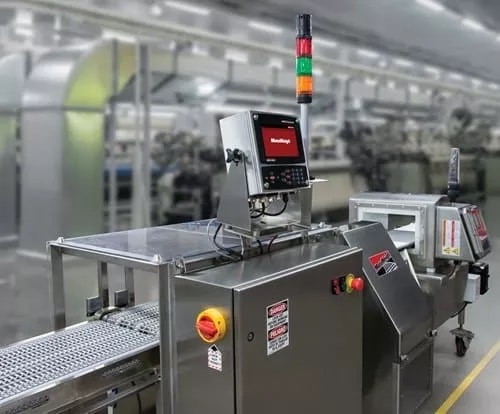Production and manufacturing professionals are discovering how adding conveyor belt scales to their existing lines can give their operations a boost in efficiency and new capabilities. Today’s conveyor scale systems allow production schedulers to merge the jobs of transporting and weighing materials.
If your job is to ensure that a product gets moved down a production line as efficiently as possible, you know how combining each task with other processes can potentially save production time — and in manufacturing, the faster you move, the larger the return on investment.
No matter what type of industry you represent, if you are running an assembly line or extraction process, investing in a conveyor scale system could transform your operation. This comprehensive guide by American Scale will get you better acquainted with conveyor scales, answering many common questions about them. It will also help you understand how the ability to weigh and collect data on products moving along the assembly line benefits your business immensely.
Conveyor Scales 101: Everything You Need To Know
Belt scales have been around for decades in their old analog incarnation. However, the digital age has brought about a transformation in conveyor scales as users have developed processes around the technology. As a result, belt scale manufacturers continue to improve accuracy and long-term stability as well as the variety of ways these scales are used.
Definition
A conveyor belt scale system weighs material while a conveyor belt transports it. The system monitors raw materials and products to analyze the weight moved over time, referred to as the rate. It then measures how fast the product moves through the production process and totals the amount carried.
The design of a typical conveyor scale allows process designers to integrate it into existing conveyor belt systems by removing idlers and replacing a section of the track with a weighing mechanism.
The belt scale system integrates belt-speed data with weigh data using a calculus differential equation. Digital technology allows the function to execute multiple times per second. The result is a high-resolution recording of line performance over time.
Mechanics
Belt scales measure the flow rate of bulk materials on a moving conveyor. Measuring and integrating the dynamic metrics of weight and time requires multiple steps to accomplish and includes having:
- Load cells read the weight on the belt section
- Sensors measure belt speed
- An integrator multiply the belt travel speed and weight per unit length
- A totalizer adding material mass that passes over the scale in the given time frame
While the actions outlined above are an oversimplification, they adequately describe the premise of belt scale theory.
Improvements in production methods have lowered costs and improved the performance of modular belt scales. As a result, the systems are flexible and relatively simple to reconfigure as requirements and applications evolve.
Additionally, advancing digital technology allows designers to create better and more intuitive interfaces. That feature assists floor operators in reading and interpreting data from the production floor, fueling the growth of practical uses for belt scales.
Uses for Conveyor Belt Scales
Belt scales include configurations that are suited for almost any purpose. Designers and manufacturers of belt scales create modular components that can bolt into existing conveyor systems. This approach opens up an almost limitless number of uses for the technology, and production experts are continually thinking up new ones.
Industries
Any industry that requires precision control over a production or assembly process can potentially benefit from a conveyor scale system. Several sectors rely on this technology, including:
- Mining
- Chemical
- Agriculture
- Parts Kitting
- Aggregate Mixers
- Power Production
The above list is by no means exhaustive. However, since the uses of conveyor scale systems are expanding, it is only natural to assume that the industries embracing the technology will also grow in number.
Applications
The adaptation of conveyor scales into various industries owes itself to the practical advantages it makes available. The ability to precisely monitor and control products and materials during production profoundly affects the operation’s profit potential.
So a conveyor scale implementation could be your answer, whether you are loading sacks of grain onto a barge and need to check quantities and weights or running quality control on a kitted product by weight.
Monitoring and controlling the rate of material moved is also critically important for operations like coal-fired electric plants, agricultural feed mills, and mixing processes. In these cases, operators have to slow down transport rates intentionally when required by the circumstances.
The idea is to maintain control over every aspect of the product as the conveyor system transports it from one point to the next. Process designers can also improve production rates and efficiency by collecting and analyzing data to better understand how their process performs under various conditions.
The Right Conveyor Scale for Your Business

Determining the type and configuration of belt scale you need for your operation may seem overwhelming. The sheer number of options alone can sometimes create several possible solutions that seem equally beneficial without a clear choice presenting itself. American Scale has more than 35 years of experience conferring with businesses about their custom weighing needs and would be happy to assist you with yours.
Considerations
Determining the conveyor belt system you need depends on your application and environment. For example, the throughput your operation requires, the distances traveled, and the number of process stations all factor into the final decision on a system.
It would be best if you also considered requirements specific to your application environment. For example, will you need to wash down food preparation equipment frequently or will your scales withstand continuous operation for long periods?
Another issue is whether the government regulates the measurements used to sell products in your industry. Your weighing equipment may require calibration traceable to guidelines set by the National Institute of Standards and Technology (NIST).
These and similar factors will influence the decisions you make on equipment purchases. However, once you meet the minimum hardware parameters, the system software implements most of the advanced capabilities of belt scales.
Consultation
Specialists in process design can sometimes offer insights into procedures that need refining and how you could best utilize currently available equipment. However, consultants must demonstrate an understanding of both the general principles of production and the specific challenges and opportunities of the given application to be of any benefit.
Experts can also offer help with the physical design aspects of your material weighing system and what software capabilities can help bump production up even higher than expected.
Equipment suppliers can be a good source of information on trends. They can also offer examples of similar setups that have successfully implemented a conveyor scale system. For example, the experienced sales staff and qualified service technicians at ASC take pride in providing the right custom belt scale products and maintenance services for your unique application.
Conveyor Belt Scale Installation and Maintenance
Like everything else, your application and environment play a significant role in how you install and maintain your conveyor scale. For example, you can choose idler load cells or leg load models of belt scales, depending on your configuration. Additionally, calibrating your conveyor scales will depend on the material they weigh and their continuous workload.
Placement
You want to ensure that you install the belt scale in a level section of the line, away from the entrance and exit points. Isolating the scale components from noise and vibration as much as possible will also help reduce inaccurate readings. In addition, belt scale designers help mitigate some effects of noise for applications where it is unavoidable.
Calibration
One significant factor in determining a substantial return on the investment of purchasing a belt scale system is how often to calibrate it. Periodic calibration is necessary to ensure that your belt scales read zero accurately for their location and function.
To make the necessary adjustments, you have to shut down all movement on the production line. Of course, depending on your industry and specific application, shutting down even for a short time may be unthinkable.
You would have to balance the risks associated with the belt scales slipping out of calibration and reading inaccurately with the costs of shutting down production for the time it takes to calibrate the scales back to true zero.
Regularly scheduled maintenance routines are the answer.
Determining the intervals between calibrations can be a tricky calculation, but help from industry experts and some trial and error will help you arrive at a workable routine.
American Scale Is Ready To Help

Belt scales are a terrific way to get control of your inventory and start squeezing more profit out of each unit. At American Scale, a full-service regional distributor for many leading system manufacturers, our sales and service professionals are ready to answer your questions about conveyor scale systems and how they can benefit your operation.
Don’t settle for an anonymous “conveyor scale near me” online search. When you are ready to start discussing your conveyor scale implementation project in Kentucky or Southern Indiana, reach out to one of our experts, who can help you determine your best solution.
Contact us today and let us help you design a custom solution that will fit your needs and help you achieve your production goals.




